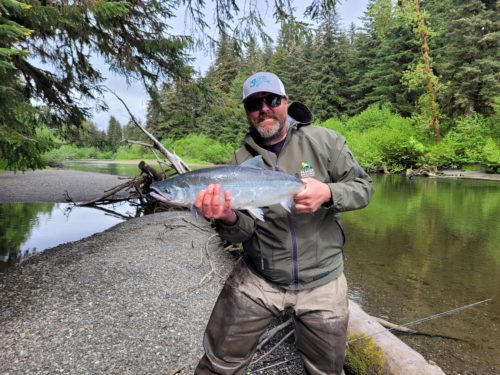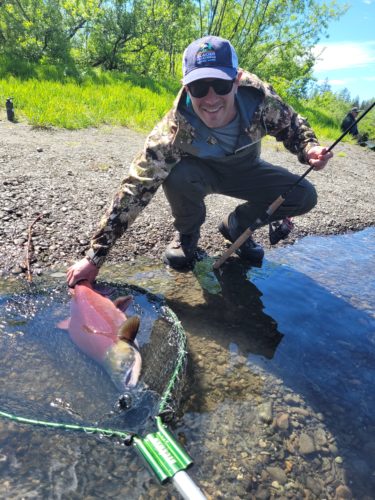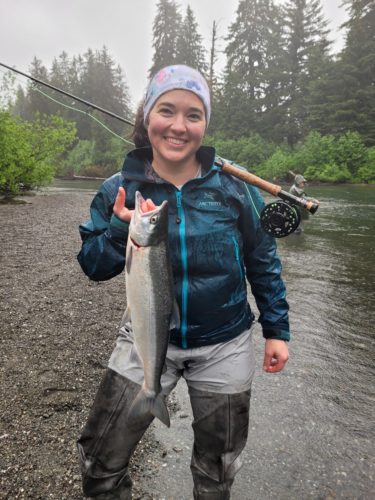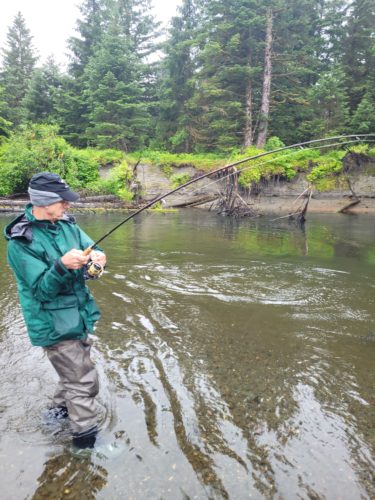
Seeing Reds: Situk Sockeye Fishing Tips

The following appears in the February issue of Alaska Sporting Journal:
BY RANDALL BONNER
When most people think of sockeye sport fisheries, they tend to think of anglers combat fishing elbow to elbow, not to mention bending their ethics as much as their rods.
Being fairly green to sockeye fishing, I can only imagine seeing red in that kind of environment. Luckily, the solitude of Tongass National Forest (the largest national forest in the United States) provides a different kind of backdrop
to an underrated fishery that lives in the shadow of larger rivers in Alaska, which only adds to what draws seasoned anglers back to Yakutat.
The area’s history and the cultural significance of the sockeye fishery as both a subsistence and commercial resource are deeply connected to the community that welcomes sport anglers to a little slice of sockeye heaven.
Today, the Situk produces roughly 60,000 sockeye every summer, but twice as many made their way above the weir in 2021, along with over 2,000 king salmon. If the correlation with Bristol Bay’s sockeye fisheries rings true again this year, there will be even more fish to catch.

FROM TOP TO BOTTOM, drift boat traffic is fairly light on the 14-mile float, with only a half-dozen guide boats or so on any given day. Foot traffic at the upper boat ramp can be fairly dense when the sockeye are as well, with a majority of the fish piling into only a few select locations.
The ramp at the lower end of the river has a lot more real estate for bank anglers, with the closest accessible areas only open to anglers over the age of 60. Marked by an old train trestle, the “Old Man’s Hole” carries its own nostalgic historical relevance. The railroad was established in the early 1900s as a one-of-a-kind operation that primarily shipped raw fish as its freight, traveling 11 miles from the Situk to the cannery in Yakutat. This designated area of the river provides easy access for seniors to fish close to the boat ramp parking lot, with the nearby open-water flats and gravel bars making for an ideal environment to target fish with a fly rod.
Upstream, there’s easily accessible trails that lead to a few pools where tidal fish tend to move in and stack up. Tides can determine a lot of the potential for success, with even tides often bringing in more fish than those with bigger swings from low to high. Log jams and deep troughs slow down the sockeye’s march upstream, but the biggest obstacle to fish passage is of course the weir itself.
The deadline below the weir is a fairly popular destination for anglers on foot, but it’s a little bit of a hike to get there, with some fairly decent water along the way that often gets overlooked.
Tidal fish moving in from the salt provide the best quality table fare, and like fish in a barrel, they often get trapped in deeper pools as the tide begins to drop again. Most of the water near the lower end is easy to cross on foot and fish from both sides of the river during the low- water periods of midsummer.

BY FAR, THE BEST way to fully experience the Situk sockeye run is from a boat. They offer plenty of fishing advantages, but the winding, scenic stretches of pristine water and ideal habitat are a sight to see on their own. The stealth of a drift boat often offers opportunities to view shorebirds, waterfowl, beavers, otters and even brown bears and moose.
While lodges offer rentals, booking a trip with a guide is always a safer bet than trying to figure things out from scratch during a 14-mile float. During the beginning of the season, the small pods of salmon may be difficult to find but the guides know where they tend to congregate. And in the peak season, while the river can be stuffed with fish from top to bottom, knowing what pieces of real estate are most effectively targeted comes naturally for someone who is on the river on a daily basis.
During the middle of the season, areas like the confluence of the old Situk are popular destinations, but often that water holds more spawning-phase fish than chrome keepers. While some of those spots are fun to rope in a few gnarly bucks for photos, they can also be a bit of a time warp that makes for a long day with a lot of river left to float downstream in order to reach the ramp. Still, they’re productive enough that if you spend enough time there and play the odds, you’re very likely to rope in a ton of fish and fill a stringer full of chrome.
Most of the fish that are on the move tend to congregate in schools in the deeper channels. Upstream, the majority of those deeper channels flow alongside heavy brush lines and through winding bends. If fish are congregating in the transitional areas of the channel going from one side of the river to the other, they can be easier to target in open water with less potential of casting into the brush. As a general rule, the shallower a run with fish is, the easier it is to target them, as they have less room to move around in the water column.
LIKE MOST SOCKEYE FISHERIES, flossing is the name of the game when it comes to filling the freezer. Although there are often situations that produce legitimate biters, that conversation is up for debate, and that strategy is more experimental than effective most of the time.
Casting at 45-degree angles from 10 o’clock to 2 o’clock or vice versa, depending on the side of the river you’re facing, produces results. Begin by making a cast upstream, then allowing your gear to sink with the rod tip low, sweeping your gear through the schools of fish.
As the fish are facing upstream, your best chance of a hookup will come when your gear is 90 degrees from the boat – or in the “noon” position – perpendicular to the direction the fish are facing. Casting behind the boat and dragging a long leader parallel to fish is a futile gesture, as your gear is drifting in line with the fish.
Casting downstream is pointless, as your gear will simply lift to the surface and go over the fish. Fish will often swim right alongside the boat, much to the frustration of the angler attempting to target them. Fish that are 15 to 20 feet from the boat are much easier targets for this technique, but most importantly, you need lots of fish to target to make it worthwhile. A dozen or two is not enough fish. If there’s not 50 to 100 around, you’re almost wasting your time and should look for bigger pods.
Fishing from shore isn’t much different; find fish and keep casting. Sockeye fishing is a numbers game, and as much as you’ll benefit from finding more fish to target, you’ll need to make more casts to catch them. If you lose a fish, don’t sweat it; there are plenty more out there, so keep casting. One thing is for certain, you will not catch them on a dry hook pouting about the last one that got away.
While fishing 45 degrees upstream from a boat is deadly, fishing straight across or even slightly downstream from the bank is often more effective if you’re fishing the opposite shoreline.
The long distance your line travels during the drift will often leave a bow in your mainline that slowly drags your gear behind it. Ideally, your line should be tight to the gear in order to feel the fish and hook it more effectively. Fish that are closer to you can be targeted effectively with shorter casts.
The sweeping motion helps you determine the speed at which your gear is traveling through the run. Sweeping your rod tip low, slow and downstream will give you more control over the movement of your presentation than reeling.
The only reasons you should turn the crank on your reel is to pick up slack, reel in a fish or finish your last cast and prepare for the next one. Most people don’t take into consideration just how fast turning the crank on the reel picks up the line. If you’re picking up line too fast, your gear will be near the surface and floating over the fish. If you’re going too slowly, you’re dragging below them and likely to snag on the bottom or foul-hook fish. If you’re reeling your gear in like a bass lure or letting it sit on the bottom like a catfish bait, you’re not going to catch very many sockeye.

THE DEPTH AND SPEED of a run should determine how it’s fished. A deep, slow- moving run will often have fish at varying depths in the water column. Allow your gear time to sink, but don’t drag the bottom. Count a few seconds, then begin your sweeping motion. If you’re not feeling fish, count more or count less until you do. If you’re still not feeling them, then maybe there’s not enough there to target.
Sockeye in shallow water with no cover are sitting ducks, but once they discover this, they won’t be there for long. If the fish are out on a shallow flat, it can be a fast and furious rodeo for a few minutes before they move into brush, deeper water or simply drift up- or downstream. If you can keep the fish below you, they’ll eventually move back up. Once they’re above you, they’re hard to get back down.
Most seasoned guides crimp on four to seven extra-large split shot about 5 feet up their mainline, which is typically 20-pound monofilament, then place a large Corky a few inches below the weights to lift the line between the weight and the hook into the water column to find the fish’s jaws just above the river bottom. While this is effective, being a fresh set of eyes on a new-to- me fishery, all I could see were simple problems with very simple solutions. The split shot rigging style is extremely time- consuming and less effective than using more streamlined rigging components.
As a seasoned bead angler, I designed my own rigging to mimic the local standard and added a few of my own components to increase my chances. For starters, a long piece of pencil lead is much more efficient to add to the line than crimping multiple split shots.
Also, the bulky nature of multiple split shots is less streamlined, but a thin piece of pencil lead can potentially travel through a fish’s jaws if they’re flossed on the mainline far from the hook. I thread one bead above and below a 3- to 5-inch piece of pencil lead onto 20-pound monofilament as my mainline. The top bead prevents the lead from damaging the ceramic rod tip, and the bottom bead prevents the lead from damaging the terminal tackle. Tie that 20-pound monofilament mainline to a barrel swivel.
All this gear can easily travel through a sockeye’s jaws if you’re slightly off target and floss them with the mainline. Below the swivel, thread a small 6mm bobber stop bead and an 8mm Thirsty Fishing bead on a 4-foot, 20-pound fluorocarbon leader to a size 1 octopus hook. The 6mm plastic bead will prevent the Thirsty Fishing bead from sliding down onto the hook.
This rigging can easily be duplicated with small Corkies, but there are a few advantages to using the Thirsty Fishing bead, which is essentially a spongy, buoyant, perfectly round bead. For starters, it’s significantly more buoyant, balancing the sinking properties of the fluorocarbon leader, which is stiffer than monofilament and more likely to “fly” straight through the drift. These facets place the line in an ideal position to find sockeye in their jaws, particularly in the slower-moving waters of the Situk’s lazy, winding currents. The spongy texture of the bead itself also acts as less of an obstruction in the hook gap, and creates more opportunity for the hook point to grab.
Reading the regs that allow for a maximum of two single-point hooks was a breakthrough, knowing what I have learned from other fisheries in which I’ve added a second leader to my presentation.
During fall 2019, while fishing with Ty Wyatt and Sam Wurdinger, I was attempting to catch chum on a bead trailer tied to a large salmon jig. Time after time, as soon as I hooked up I would lift my rod and raise the fish to the surface to see if I could spot some marabou hanging out of its mouth.
Several times that day, I confirmed that the chum had bit the jig, but when they went on another run and did their trademark underwater death roll a few times, the line would go slack for a split second and I’d continue fighting the fish to the net, only to realize they had spit the jig and insta-flossed themselves with the bead trailer. This got me wondering how many times I’ve been bobber dogging for steelhead and caught fish on the trailer.
The bead trailer usually accounts for a large majority of my fish, but I often couldn’t catch fish in the same hole fishing a single-bead presentation. There had to be a yarnie or some bait above it, yet they always came in on the trailer.
The next year, I fished two-bead leaders the entire season as an experiment. What I found was that I lost very few fish, which again made me wonder how often they bit the first bead, then rolled out of the hook and flossed themselves with the trailing leader as somewhat of a “safety net” for my fish.


APPLYING THOSE PERSONAL EXPERIENCES to the sockeye fishery really helped speed up the catching curve. There were some days that so many fish came in on the Thirsty bead that I was convinced they were eating it. Then there were days I only caught fish on the secondary leader, which made me believe even more that they avoided the bead.
Either way, adding a secondary leader seems to catch twice the fish in half the time, but involves using equipment that fits the program. While the typical 7-foot light rods will still work, they’re very limiting. Even with a 6-foot leader, you’re going to lose more than a foot of lift when the rod bends, which makes it more difficult to bring a fish to the surface and into the net.
You can sacrifice length, but every inch of leader provides more potential opportunity to hook a fish. Having two longer leaders doubles that potential opportunity, but makes it a little more challenging to land fish, especially on the trailing hook.
A 9-foot, 6-inch rod will both cast and land fish more effectively. Longer rods suited for steelhead will help lift sockeye to the net, but cooperation on the angler’s part to reel all the way down to the gear, lift higher and take a step back will help the net man put fish in the bag.
Sockeye don’t exactly have a reputation for giving up, rolling over and tiring out. That they will swim upstream and spawn is what makes them incredible fighters.
During the late season, it’s not uncommon to land Dolly Varden, Chinook, coho, pinks and sockeye all in the same day, against a backdrop of brown bears and fireweed. While sockeye are typically considered a “food fish” rather than a sport fish, the scenery, environment, variety of recreational opportunities, and the community of Yakutat are what make this particular fishery something special. ASJ
Editor’s note: This is the first of a two- part series on the Situk River. Next month, Randall Bonner talks Situk steelhead.



